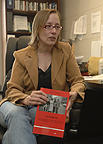June 05, 2007
Book details chapter of French film history

Caption Follows story
A book by film historian Sally G. Shafto, executive director of the Big Muddy Film Festival at Southern Illinois University Carbondale, details a little-known chapter of French film history.
"The Zanzibar Films and the Dandies of May 1968," looks at a group of young filmmakers who focused both on aesthetics and sought "to make films in a new way out of the traditional commercial market," Shafto said. The copiously illustrated 256-page book is bilingual, with text in both English and French.
Zanzibar refers to a collection of 15 to 20 films financed by young French heiress Sylvina Boissonnas over about a two-year time period between spring 1968 and February 1970. The films were "all motivated by the desire to change the face of French cinema," said Shafto, a native of Lenox, Mass.
"Forty years later this may sound very naïve, but these people were really very sincere in what they were trying to do," Shafto said. "They were trying to make films differently."
The book includes narratives on the films, interviews with many of the filmmakers, and short biographies of those involved with Zanzibar.
Shafto will hold a book signing Wednesday, June 27, at the Pompidou Centre in Paris. In addition, three Zanzibar films, "The Virgin's Bed, (Le Lit de la vierge)" by Philippe Garrel, "Quickly (Vite)" by Daniel Pommereulle, and "Twice Upon a Time (Deux fois)" will be shown Friday, June 15, and Saturday, June 16, at the LaSalle Bank Cinema, 4901 W. Irving Park Road, Chicago.
The French youth movement in May 1968 parallels many of the events in the United States during the same period, serving "as a fulcrum for galvanizing the energies of these young people in some way," Shafto said.
The exploding civil rights and women's movements in the United States were gaining momentum in France. Many of the 35mm-films capture the themes of the student protests in France.
Most of the filmmakers did not go to film school and bypassed French requirements for becoming a director or director of photography. Instead, they made movies without permission of the Centre national de la cinematographie, the French government agency— a requirement for distributing films.
"Instead of taking 10 years (of study) to make movies — they said, 'the power is now; we want to make movies now," Shafto said.
May 1968 historians generally were unaware of the films' existence until Shafto, a film historian who specializes in international cinema with a strong background in French culture and film theory, wrote about them for an article for Cinemathèque Francaise in 1999. Some of the films are now available on DVD, she said.
Part of book focuses on Boissonnas, a niece of art patron Dominque de Menil, who founded the de Menil Collection in Houston. Boissonnas funded many of the filmmakers largely upon their appearance, Shafto said.
The generation still affects society today, Shafto said.
"The players in this group were all in the first crest of the baby boom generation," born between 1942 and 1950, Shafto said.
"The first wave really came in with a feeling that the world was theirs … they were going to effect a takeover," she said. "School was not as important because diplomas were not what mattered; what mattered was having some ideas and the energy and willingness to do it."
Shafto works in the University's cinema and photography department, which is a part of the College of Mass Communication and Media Arts.
Before coming to SIUC in 2006, Shafto served as the English Web site translator for the French film journal Cahiers du cinema. She also served as an assistant director for the Avignon Film Festival in France, where she lived since moving there in 1998 to finish her doctorate.
She has a master's degree in art history from Columbia University and earned her doctorate in film studies at the University of Iowa. She was curator of Zanzibar Films at the Institute of Contemporary Art, Harvard Film Archives in London and co-organizer of a conference titled "Religion and Cinema" at Princeton University. She taught various classes in film at the Institut International de l'Image et du Son in Trappes, France and at New York University's Tisch School of the Arts, among other experiences.
For more information about the book, contact Shafto at sgshafto@siu.edu. The book is available through http://www.cine-memento.fr/sally-shafto-a-149708.html for about $36 (not including postage) or 27 euros. Bookstores may also order the book by contacting Philippe Magnani, director of the Paris Museum International, at pmagnani@paris-musees.asso.fr.
Caption: Zanzibar in retrospect — Film historian Sally G. Shafto, executive director of the Big Muddy Film Festival at Southern Illinois University Carbondale, discusses her book, “The Zanzibar Films and the Dandies of May 1968.” The bilingual book, with text in both English and French, details a little-known chapter of French film history between spring 1968 and February 1970 — a collection of 15 to 20 films by a group of young filmmakers. The book includes narratives on the films, interviews with many of the filmmakers, and short biographies of those involved with Zanzibar.
Photo by Steve Buhman
